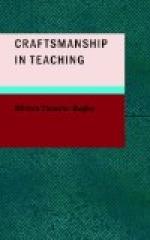One of the best teachers that I ever knew taught the subject that we now call agronomy,—a branch of agricultural science that has to do with field crops. I was a mere boy when I sat under his instruction, but certain points in his method of teaching made a most distinct impression upon me. Lectures we had, of course, for lecturing was the orthodox method of class instruction. But this man did something more than merely lecture. He assigned each one of his students a plat of ground on the college farm. Upon this plat of ground, a definite experiment was to be conducted. One of my experiments had to do with the smut of oats. I was to try the effect of treating the seed with hot water in order to see whether it would prevent the fungus from later destroying the ripening grain. The very nature of the problem interested me intensely. I began to wonder about the life-history of this fungus,—how it looked and how it germinated and how it grew and wrought its destructive influence. It was not long before I found myself spending some of my leisure moments in the library trying to find out what was known concerning this subject. I was not so successful as I might have been, but I am confident that I learned more about parasitic fungi under the spur of that curiosity than I should have done in five times the number of hours spent in formal, meaningless study.
But the point of my experience is not that a problem interest had been awakened, but rather that the white heat of that interest was not utilized so completely as it might have been utilized in fixing upon my mind some important details in the general method of running down references and acquiring information. That was the moment to strike, and one serious defect of our school organization to-day is that most teachers, like my teacher at that time, have so much to do that anything like individual attention at such moments is out of the question.
Next to individual attention, probably, the best way to overcome the difficulty is to give class instruction in these matters,—to set aside a definite period for teaching pupils the technique of using books. If one could arouse a sufficiently general problem interest, this sort of instruction could be made most effective. But even if the problem interest is not general, I think that it is well to assume that it exists in some pupils, at least, and to give them the benefit of class instruction in the art of study,—even if some of the seed should fall upon barren soil.
This aspect of teaching pupils how to study is particularly important in the upper grades and the high school, where pupils have sufficiently mastered the technique of reading to be intrusted with individual problems, and where some reference books are commonly available. Chief among these always is the dictionary, and to get pupils to use this ponderous volume effectively is one of the important steps in teaching them how to study. Here, too, it is easy to be pedantic.




